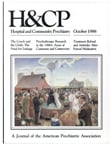Psychiatrists' Accuracy in Predicting Violent Behavior on an Inpatient Unit
Abstract
Courts and legislators continue to assume psychiatrists are able to predict dangerousness, but research has shown they have no special ability to do so. In this study, two psychiatrists examined 47 new inpatient admissions to a short-term psychiatric treatment unit and predicted whether they would commit battery or demonstrate threatening or suicidal behavior within seven days. The psychiatrists were not accurate in predicting battery or suicidal behavior but had some efficacy in predicting threatening behaviors. The presence of assaultive or threatening behavior on admission, hallucinations on mental status examination, and a discharge diagnosis of mania were useful for predicting battery. A discharge diagnosis of mania was useful for predicting threatening behavior. The use of likelihood ratios to conceptualize predictive data is described.
Access content
To read the fulltext, please use one of the options below to sign in or purchase access.- Personal login
- Institutional Login
- Sign in via OpenAthens
- Register for access
-
Please login/register if you wish to pair your device and check access availability.
Not a subscriber?
PsychiatryOnline subscription options offer access to the DSM-5 library, books, journals, CME, and patient resources. This all-in-one virtual library provides psychiatrists and mental health professionals with key resources for diagnosis, treatment, research, and professional development.
Need more help? PsychiatryOnline Customer Service may be reached by emailing [email protected] or by calling 800-368-5777 (in the U.S.) or 703-907-7322 (outside the U.S.).



